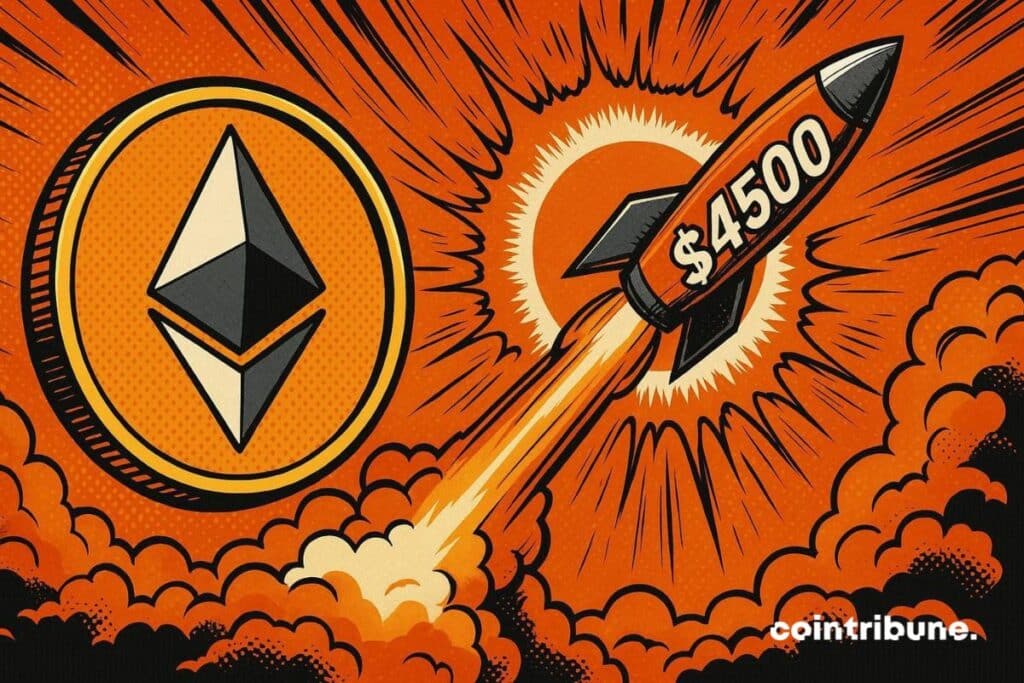Ethereum Rebounds Toward $4,500 After Flash Crash: A Turning Point?
In less than 48 hours, ethereum lost 20% of its value before rebounding with the same intensity. Does this flash crash mark the end of a correction or the beginning of a new ascent towards $4,500? Analysis of technical signals, fundamentals, and crypto market sentiment.

In brief
- Ethereum fell 20% in 48 hours before rebounding, with $1 billion in liquidations and massive accumulation by whales.
- Ethereum’s technical and on-chain indicators show a solid recovery, with a rising RSI and 230,000 ETH withdrawn from crypto exchanges.
- Ethereum derivative markets stabilize, and sentiment shifts from extreme fear to neutral, paving the way to $4,500.
Ethereum flash crash: anatomy of a lightning drop in the crypto market
On October 11, 2025, ethereum dropped from $4,100 to $3,500 in a few hours, triggered by geopolitical tensions and massive liquidations. Over $1 billion in positions were liquidated in one hour, amplifying the panic. Major crypto investors, or “whales”, took advantage of this drop to massively accumulate ETH, while small wallets panicked.
This scenario recalls the crypto flash crashes of 2017, 2020, and 2021, where Ethereum (ETH) had always bounced back after sharp falls. However, the speed of recovery this time depends on the macroeconomic context and liquidity available in the markets. Similarities with past crises show that rebounds can be fast, but also volatile.
The ongoing recovery: technical and fundamental signals
Since the low at $3,500, ethereum has regained the $4,100 to $4,300 range. Technical indicators show a rising RSI, increasing from 30 to 55, and a 30% increase in trading volume. The key support at $3,800 held, which boosts investor confidence.
On-chain data confirms massive accumulation. Indeed, 230,000 ETH have been withdrawn from crypto exchanges in 48 hours, a sign that whales anticipate a rise. Addresses holding more than 10,000 ethereum rose by 8%, according to Santiment. These signals suggest a sustainable recovery, but everything will depend on the ability to break the $4,500 resistance.
Crypto market sentiment: between fear and greed
The fear and greed index shifted from “extreme fear” to “neutral” in just 48 hours. On social networks, positive mentions like “buy the dip” or “ETH to 5K” are multiplying. Crypto influencers and analysts remain divided: some call for caution, while others anticipate a new all-time high.
As ethereum prepares to reclaim the $4,500 level, retail investors are gradually accumulating, while institutions cover their short positions, a sign of regained confidence. This sentiment shift could support the recovery, but caution remains necessary due to persistent volatility in crypto markets.
Can Ethereum reach $4,500 this week?
Technical and on-chain data suggest that $4,500 is a realistic target if trading volume exceeds $40 billion per day and bitcoin maintains its position above $110,000. Whales are accumulating, and derivative markets show regained confidence.
However, risks remain:
- Insufficient volume;
- Massive profit-taking at $4,500;
- A bitcoin rejection could limit the rise.
If these obstacles are overcome, Ethereum could even exceed $4,500 and target $5,000.
While validators move away from Ethereum, derivative markets are stabilizing. Massive whale accumulation and a sentiment shift from fear to neutrality indicate that ethereum seems ready to retest $4,500. Yet, volatility persists. Does this recovery mark the start of a new bull cycle or just a pause before another correction?
Maximize your Cointribune experience with our "Read to Earn" program! For every article you read, earn points and access exclusive rewards. Sign up now and start earning benefits.
The world is evolving and adaptation is the best weapon to survive in this undulating universe. Originally a crypto community manager, I am interested in anything that is directly or indirectly related to blockchain and its derivatives. To share my experience and promote a field that I am passionate about, nothing is better than writing informative and relaxed articles.
The views, thoughts, and opinions expressed in this article belong solely to the author, and should not be taken as investment advice. Do your own research before taking any investment decisions.